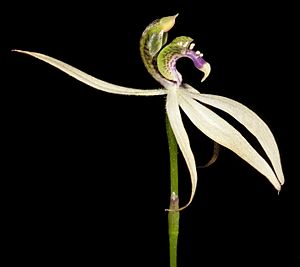Leafless orchid facts for kids
Quick facts for kids Leafless orchid |
|
|---|---|
 |
|
| P. aphyllus growing near Pinjarra | |
| Scientific classification | |
| Genus: |
Praecoxanthus
|
| Species: |
aphyllus
|
| Synonyms | |
|
|
The Praecoxanthus aphyllus, often called the leafless orchid, is a special type of flowering plant. It's the only species in its genus called Praecoxanthus. This orchid belongs to the large orchid family, Orchidaceae. You can only find it growing in the southwest part of Western Australia.
What makes this orchid unique is its name! When it's flowering, it doesn't have a true leaf. But if you see a plant that isn't flowering, it will have a green leaf. This orchid is one of the first to bloom each year, usually in autumn. Its creamy-white flowers smell lovely, which helps tell it apart from other orchids.
Contents
What Does the Leafless Orchid Look Like?
The leafless orchid is a perennial plant, meaning it lives for many years. It grows from a tuber (a bit like a potato) hidden underground. This tuber helps the plant survive and grow a new plant the next year.
Leaves and Stems
If the plant isn't flowering, it has a single, egg-shaped leaf. This leaf is about 2 to 4 centimeters (0.8 to 1.6 inches) long and 0.8 to 2 centimeters (0.3 to 0.8 inches) wide. It's smooth and has clear white veins.
When the plant is ready to flower, its leaf shrinks down to a tiny bract (a small leaf-like part) at the bottom of the stem. The stem itself is thin and grows about 20 to 40 centimeters (8 to 16 inches) tall.
Flowers and Their Parts
Each leafless orchid stem usually has one beautiful flower at the top. The flower is about 2 to 4 centimeters (0.8 to 1.6 inches) wide and long. It has three sepals and two petals that spread out. These parts are creamy-white and look similar to each other.
Like most orchids, one petal is very special. It's called the labellum, and it's the central part of the flower. The labellum of the leafless orchid has three lobes and is a mix of purple, green, and yellow. It also has two rows of unique, club-shaped bumps called calli.
The flower's reproductive parts are joined together in a structure called the column. This column has wing-like parts on its sides. The leafless orchid blooms from March to May. After flowering, it produces a dry, hairy seed pod called a capsule that holds many tiny seeds.
How Was the Leafless Orchid Named?
The leafless orchid was first officially described in 1837 by a scientist named George Bentham. He gave it the name Caladenia aphylla. Later, in 2000, two other scientists, Stephen Hopper and Andrew Brown, created the new genus Praecoxanthus and moved this orchid into it.
The name "Praecoxanthus" comes from two words. Praecox is a Latin word meaning "early" or "premature," and anthos is an Ancient Greek word for "flower." This refers to how early in the year this orchid flowers. The second part of its name, "aphyllus," also comes from Ancient Greek. "A-" means "without," and phyllon means "leaf," which describes the plant's lack of a true leaf when it flowers.
What About Its Life Cycle?
The leafless orchid's flowers have a strong, sweet smell that attracts native bees. The yellow calli (bumps) on its purple labellum look like pollen, which might trick the bees into visiting. However, these flowers don't actually produce nectar, so the bees don't get a reward. This is a clever way for the orchid to get pollinated!
Where Does the Leafless Orchid Grow?
This orchid usually grows in sandy soils found in woodlands. However, near Esperance, it prefers to grow in low heath areas where there's moisture underground. Unlike some orchids that grow in big groups, leafless orchids usually grow far apart from each other.
You can find the leafless orchid in a wide area of Western Australia. It grows between Pinjarra and Albany, and along the coast east to Esperance. It lives in several different natural areas, including the Avon Wheatbelt, Esperance Plains, Jarrah Forest, Mallee, Swan Coastal Plain, and Warren regions.
Is the Leafless Orchid Protected?
Good news! The Western Australian Government's Department of Parks and Wildlife has classified Praecoxanthus aphyllus as "Not Threatened." This means it's not currently at risk of disappearing.
See also
 In Spanish: Praecoxanthus para niños
In Spanish: Praecoxanthus para niños

